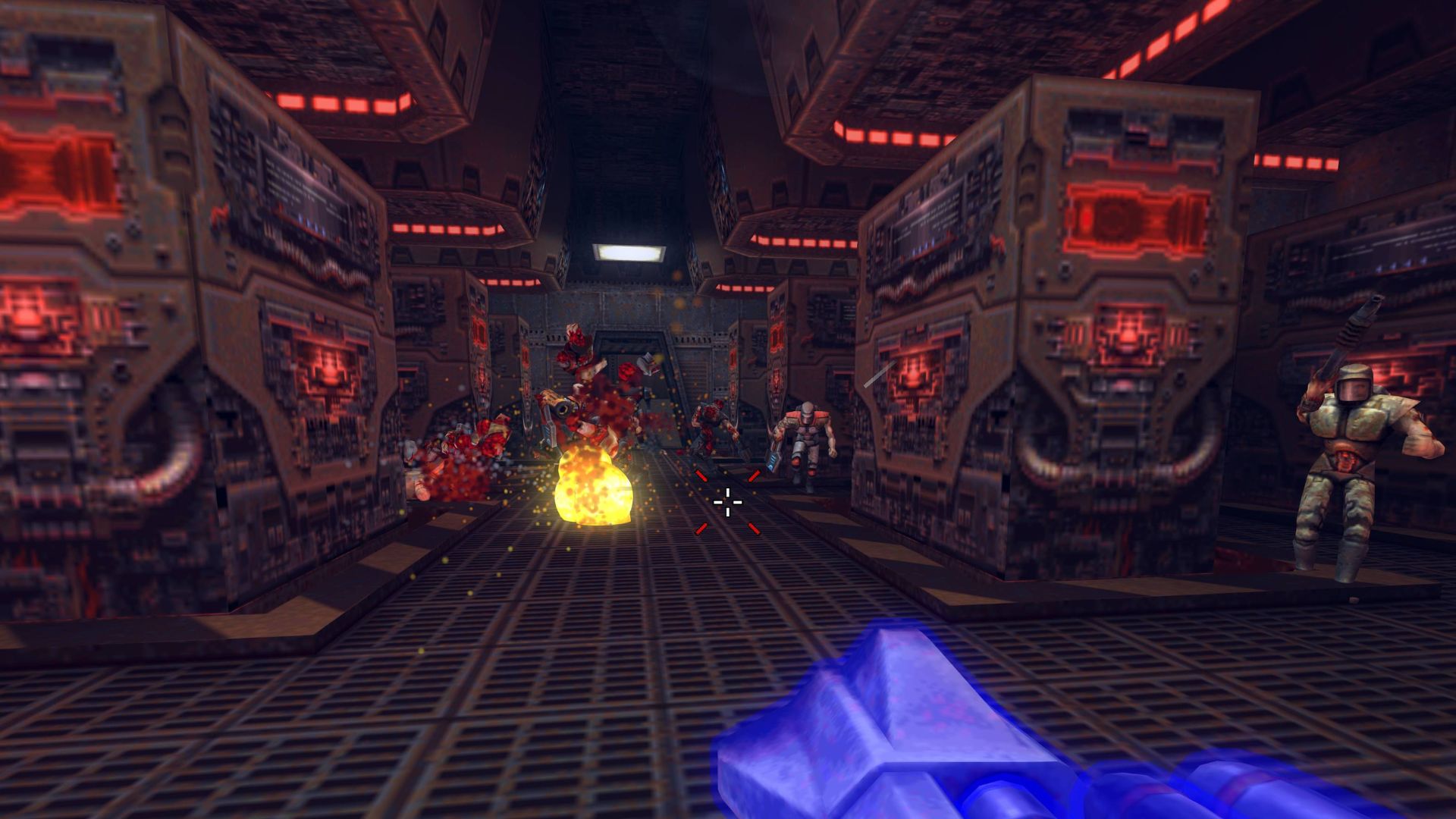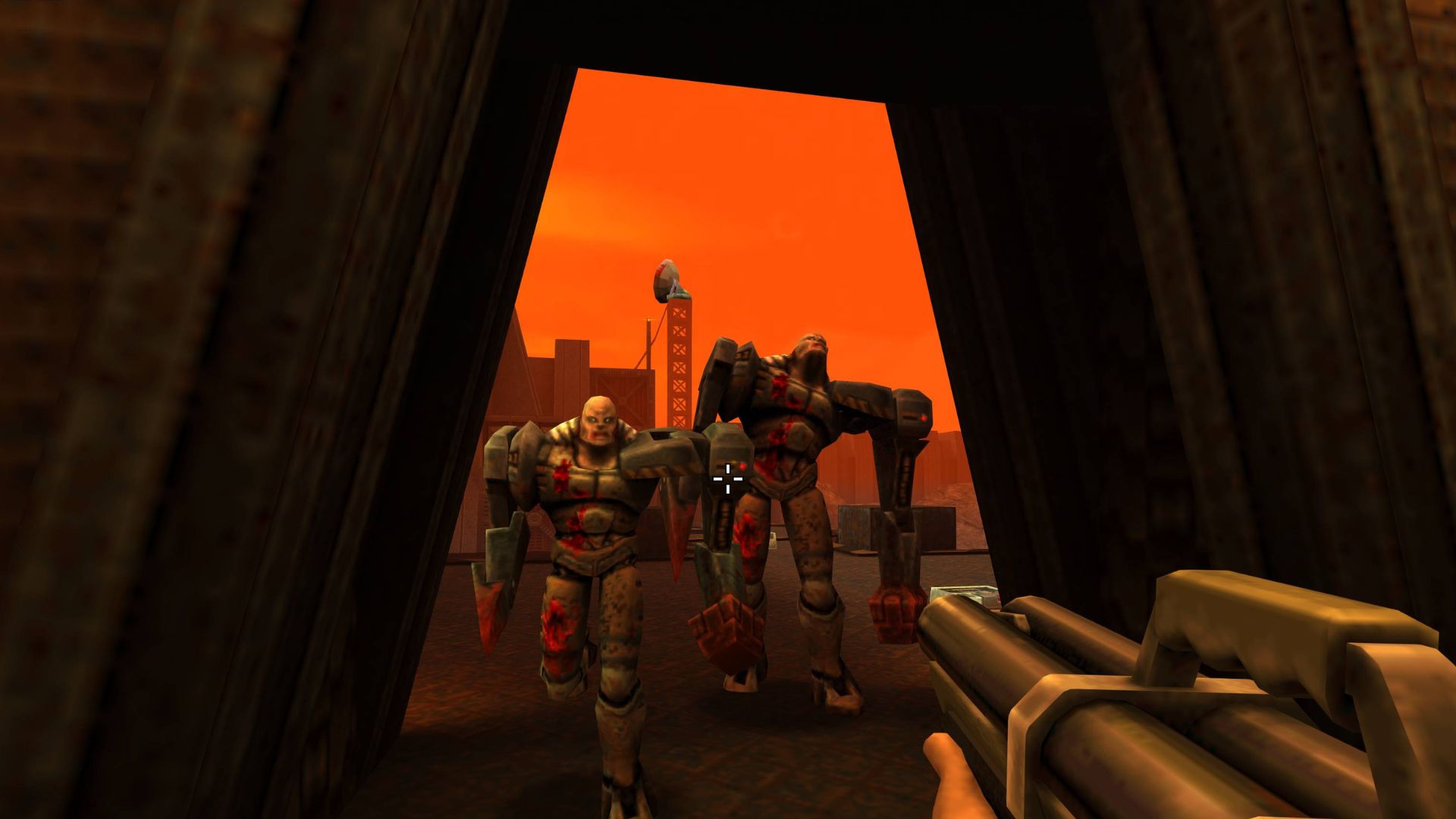
Quake 2 Remastered is a fantastic modernization of id's classic 1997 first-person shooter, but by far the best part of Nightdive Studios' overhaul wasn't made by the remastering maestros. Alongside the visual enhancements and quality-of-life improvements you'd expect from an update of this nature, Quake 2 Remastered also introduces a brand new campaign episode, titled Call of The Machine. Far from being a simple expansion pack, Call of the Machine quickly proves itself the definitive Quake 2 experience.
Created by Wolfenstein: The New Order developers MachineGames, Call of the Machine follows hot on the heels of last year's Dimension of the Machine, an expansion MachineGames designed for Nightdive's remaster of the original Quake. Like Dimension, Call of the Machine lets players select from six new Strogg-battering missions from a central hub, each built using the weapons, enemies, and aesthetic of Quake 2. But the ensuing action is both more intense and more imaginative than anything the original game conjures.
A sign of the times

To understand the difference, you first need to know how Quake 2 itself operates. Designed when the PC gaming technological arms race was at its most intense, Quake 2 was intended as a more "realistic" shooter than the original. It ditched Quake's vague gothic fantasy setting for a more defined sci-fi universe where humanity was locked in a galactic battle with a race of cyborgs called the Strogg. Instead of levels designed as individual, abstract mazes, Quake 2 strived to make its environments look like believable locations such as prisons and power stations, with many levels stitched together to form elaborate "Units". Instead of madcap, lightning-paced shooting, Quake 2 favored a slower, more methodical approach, with players battling small handfuls of tough, highly detailed enemies.
In 1997, this was all hugely exciting, representing significant steps forward in game design that Half-Life would go on to master. Today though, the downsides of this approach are far more apparent. The game's levels often feel cramped, sparsely populated, and creatively restrained by their more realistic aspirations. It's worth noting that some of these shortcomings are due to a change in how PC games are played. Quake 2 was launched at a time when shooters were still predominantly played with both hands on the keyboard, which made looking around slower and combat therefore more challenging. Nonetheless, Quake 2 suffers more from the addition of mouselook than other games id made before it.
Moreover, these challenges are considerably more substantial than what Quake 2 offers
In any case, it's these issues that Call of the Machine addresses, and the difference it makes to Quake 2's play is remarkable. This is most evident in the levels, which do a far better job of navigating Quake 2's highwire act of balancing old and new design ideas. Call of the Machine maintains the large, interconnected Strogg facilities built from Quake 2's hostile industrial architecture, but they're no longer basic corridor runs where you're fighting one or two enemies at a time. Instead, MachineGames' levels fold in airy combat arenas and elaborate set-pieces, ensuring each part of the level is built around a specific, identifiable challenge.
Moreover, these challenges are considerably more substantial than what Quake 2 offers. Since each mission is a self-contained adventure that sees you playing a different marine, they have a shorter power arc that ramps up much more quickly. Within ten minutes of beginning Operation Firewall, for example, you'll have picked up most of Quake 2's existing arsenal, which you'll use to fend off dozens of enemies, some of which the original game took half its length to introduce.
In this manner, MachineGames unlocks much of Quake 2's latent potential. Quake 2's weapons, for example, are afforded much better spotlights in the scenarios MachineGames has built around them. When you pick up the railgun in Operation Firewall, the level responds by flooding the area with blaster-toting guards, letting you experiment with the railgun's penetrative capabilities for maximum carnage. The higher density of enemies also makes weapons like the grenade launcher far more useful, and there are plenty of opportunities to exploit its bouncy projectiles. My favorite moments across the episode are when it locks you in a roomful of enemies with a chaingun, letting you go absolutely ham with it.
One step forward, two steps back

Likewise, Call of the Machine gets the best out of Quake 2's enemies. Strogg that only appeared occasionally in Quake 2, like the Medic who can revive enemies, and the creepy-looking Brains, have a far more prominent role here. As with the weapons, Call of the Machine will often create challenges around specific foes. One mission has a particularly brilliant encounter involving Quake 2's rarely-seen Mutant, involving a BFG and a dark, vertical labyrinth. The episode also pulls in weapons and enemies from the expansions, like the Hyper Blaster Guard and the Particle Cannon, and even introduces a new enemy - the Gunner Commander - all of which helps enhance the variety of firefights.
One notable exclusion from Call of the Machine is the Iron Maiden, the sole female Strogg whose bizarrely sexualized appearance stood out even in 1997. Given the progressive attitude demonstrated by MachineGames in its previous work, it isn't massively surprising that this foe has been quietly sidelined. It doesn't make a huge difference mechanically, either. Other foes like the Tank and the Beta Class Gladiator make up for the absence of the Iron Maiden's rocket launcher. In short, you aren't cheated of the opportunity to be blown to smithereens.
The result is a vision of Quake 2 that feels more aligned with the other Quake games that id Software made
Finally, Call of the Machine strives to increase the variety of places you explore. Missions like Operation Ruined Earth pull you away from the industrial landscapes of the base game, while Operation Darkest Depths channels original Quake more than it does the sequel. One of the campaign's highlights transports you to the Moon in a direct reference to Wolfenstein: The New Order. All that said, there is only so much color MachineGames can add to Quake 2 without completely diluting its rusty essence, and the episode still has its fair share of indistinct grey-brown tunnels and corridors.
For the most part, though, Call of the Machine does a fine job of revitalizing id Software's least-relevant shooter. Like the base game, it still has one foot in the past and one in the present, but they are the opposite feet now. Those things that made Quake 2 feel modern on its release - the interconnected levels, the enemies with advanced behaviors, and the iron-oxide aesthetic - are now the elements that tickle your nostalgia. But it's all contained within levels built from lessons relearned in the more recent wave of retro-inspired shooters, which emphasizes speed, reactivity, and variety over narrative realism. The result is a vision of Quake 2 that feels more aligned with the other Quake games that id Software made, a ferocious, unrelenting gib-fest with surprises around every corner.
Our list of the best FPS games will offer you a bit more action if you're looking for a way to test your skills.







